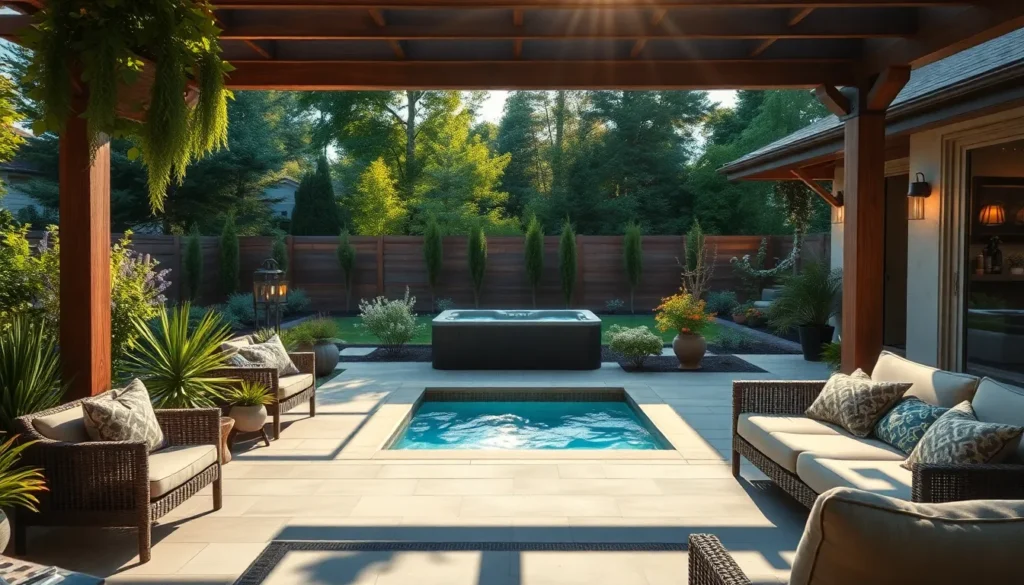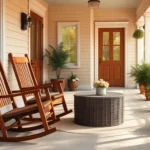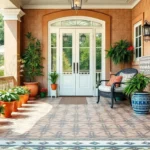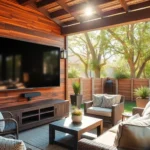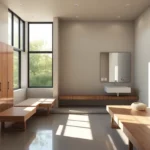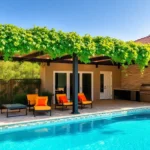We’ve all dreamed of transforming our backyard patio into a luxurious retreat where we can unwind after long days. A hot tub isn’t just a backyard addition – it’s your gateway to creating an outdoor oasis that’ll make your neighbors envious and your family grateful.
Whether you’re working with a sprawling deck or a cozy corner patio, we’ll show you how to seamlessly integrate a hot tub into your outdoor space. From sleek modern designs that complement contemporary homes to rustic setups that blend naturally with garden landscapes, the possibilities are endless.
The best part? You don’t need a massive budget or professional contractor to create something spectacular. With the right planning and creative vision, we can help you design a backyard hot tub setup that maximizes both relaxation and style while adding serious value to your home.
Sunken Hot Tub Designs for Seamless Patio Integration
Sunken hot tubs create the ultimate seamless transition between your patio and relaxation space. These designs eliminate the jarring visual break that above-ground models often create, making your outdoor area feel more cohesive and professionally designed.
Built-In Stone Surrounds
Natural stone surrounds transform your sunken hot tub into a permanent industry feature that looks like it’s always belonged in your backyard. Flagstone creates clean lines and works beautifully with both modern and traditional patio designs, while fieldstone offers a more rustic appearance that complements natural garden settings.
Stone selection directly impacts both aesthetics and functionality of your hot tub area. Sandstone provides excellent slip resistance when wet, making it ideal for high-traffic areas around the tub entrance. Limestone offers durability and comes in various earth tones that blend naturally with most patio color schemes.
Coping stones around the rim create a finished edge that conceals the hot tub shell and provides comfortable seating. We recommend using stones that are at least 12 inches wide to ensure adequate space for drinks, towels, and comfortable sitting. Thermal bluestone maintains comfortable temperatures even in direct sunlight, preventing burns on bare skin during summer months.
Deck-Level Installation Options
Deck level installations create the most dramatic visual impact by placing your hot tub flush with your patio surface. Composite decking around a sunken hot tub requires proper support beams rated for 150 pounds per square foot to handle the weight of water and occupants. Cedar planking naturally resists moisture and insects while providing a warm, organic feel that complements stone accents.
Access panels built into the deck design allow easy maintenance of pumps, filters, and plumbing without disrupting your patio’s appearance. These panels should be removable but secure, typically measuring 24 by 24 inches for standard equipment access. Hinged sections work better than completely removable panels, as they prevent accidental drops into the equipment area.
Drainage systems beneath deck level installations prevent water damage and extend the life of your patio materials. Installing French drains around the perimeter diverts overflow water away from your home’s foundation. Gravel beds beneath the decking provide additional drainage while creating a stable base for your hot tub installation.
Underground Plumbing Considerations
Underground plumbing for sunken hot tubs requires careful planning before any excavation begins. PVC pipes rated for hot water applications must be properly insulated to prevent heat loss and protect against freezing during winter months. Foam pipe insulation reduces energy costs by maintaining water temperature as it travels between your hot tub and equipment.
Electrical connections for sunken installations need weatherproof junction boxes located at least 5 feet from the water’s edge according to National Electrical Code requirements. GFCI protection is mandatory for all hot tub electrical systems, and we recommend having a licensed electrician handle all electrical work to ensure safety and code compliance.
Equipment placement affects both maintenance access and noise levels in your outdoor space. Pump systems should be located within 25 feet of your hot tub to maintain proper water circulation, while heater units work most efficiently when placed even closer to reduce heat loss through long pipe runs. Sound dampening enclosures around equipment reduce noise levels by up to 10 decibels, creating a more peaceful patio environment.
Elevated Hot Tub Platforms with Multi-Level Decking
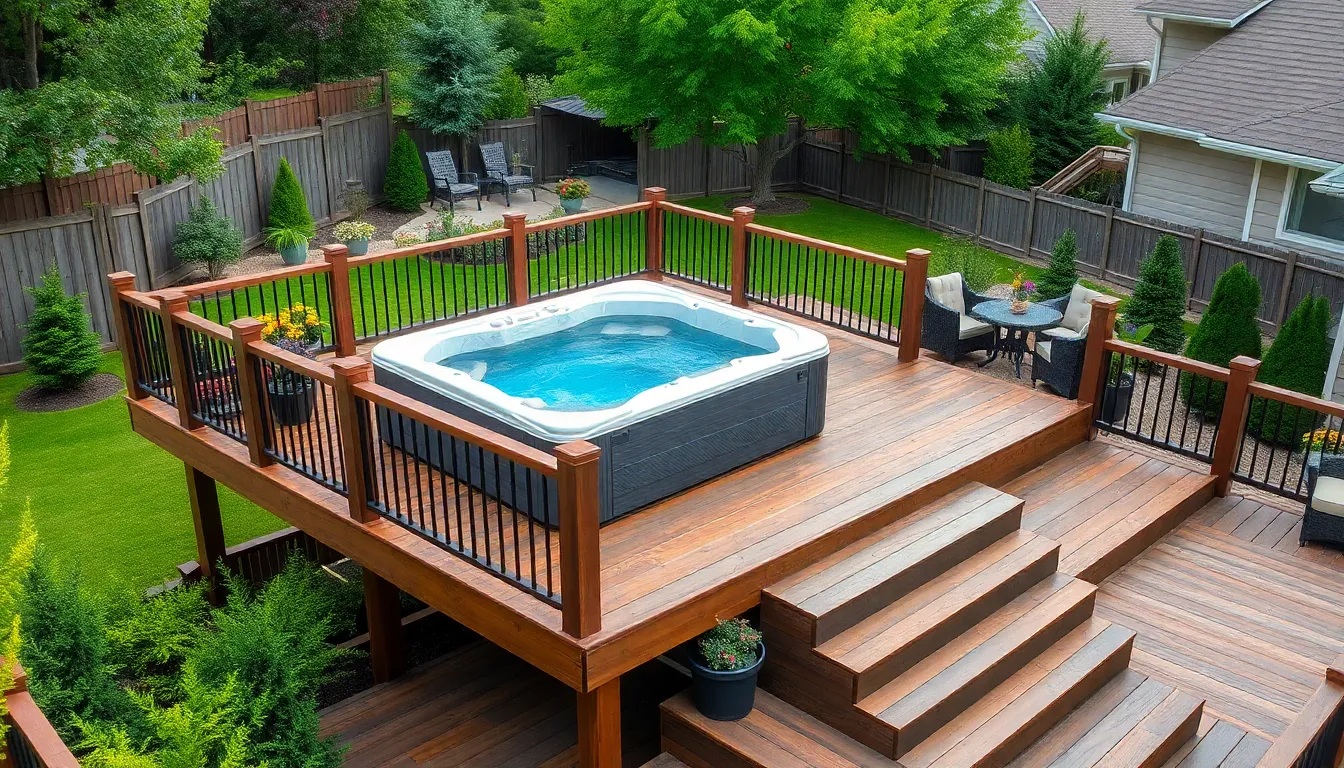
Elevated platforms transform your hot tub into a stunning focal point while maximizing vertical space throughout your backyard patio design. Multi-level decking systems create distinct zones for entertaining and relaxation, separating your hot tub area from dining spaces or lounging areas.
Raised Wooden Deck Designs
Raised wooden decks offer unmatched versatility and natural appeal for your hot tub installation. Western red cedar, redwood, and thermally modified woods provide exceptional durability while maintaining beautiful aesthetics that complement any outdoor space. Custom wooden platforms accommodate uneven terrain effortlessly, making them perfect for varied industry conditions.
Built-in steps integrate seamlessly with raised deck designs, providing safe access while maintaining visual continuity throughout your patio area. Surrounding railings crafted from matching wood materials create a cohesive look that enhances both safety and style. Integrated seating areas and towel rests add functional convenience directly into your deck design.
Gazebos and pergolas combine beautifully with raised wooden platforms to provide shelter and architectural interest. Multi-layered wooden structures help define different entertainment zones while maximizing views of your surrounding industry.
Composite Material Benefits
Composite decking materials deliver superior durability compared to traditional wood options for hot tub installations. Wood fibers and plastics combine to create surfaces that resist moisture, fading, and staining effectively in wet environments. Maintenance requirements decrease significantly with composite materials, saving you time and effort over the years.
Slip resistance becomes a critical safety feature around hot tub areas, and composite materials excel in providing secure footing. Weather resistance makes composite decking particularly valuable in harsh climate conditions where traditional materials might deteriorate quickly. Eco-friendly properties appeal to environmentally conscious homeowners seeking sustainable outdoor answers.
Longevity stands out as a primary advantage of composite materials, often lasting decades with minimal upkeep required. Color consistency remains stable throughout the material’s lifespan, eliminating concerns about fading or weathering that affect natural wood surfaces.
Safety Railing Integration
Safety railings around elevated hot tub decks prevent falls while boosting user confidence during entry and exit. Local building codes typically require exact railing heights and spacing, making professional consultation essential for compliance. Wood and composite railing materials can match your deck perfectly, creating seamless visual transitions throughout your design.
Minimalist railing designs preserve unobstructed views while meeting safety requirements effectively. Robust railing systems provide enhanced security for families with children or elderly users who need additional support. Strategic placement helps delineate hot tub spaces without compromising the overall aesthetic appeal of your patio.
Design flexibility allows railings to incorporate decorative elements like built-in planters or lighting fixtures. Custom railing configurations can follow curved deck lines or create interesting geometric patterns that enhance your outdoor space’s visual appeal.
Corner Hot Tub Installations for Space Optimization
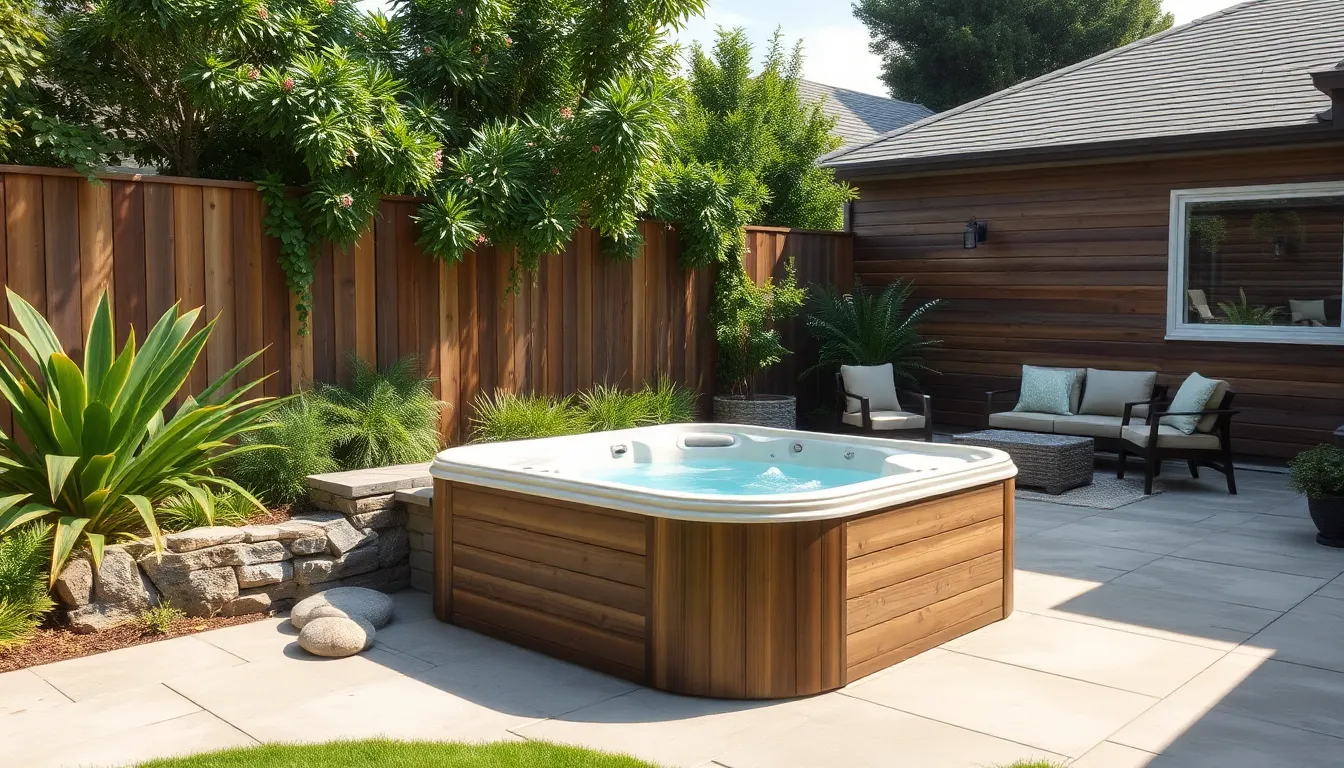
Corner installations transform unused spaces into functional relaxation zones without compromising your patio’s layout. Strategic placement in these areas maximizes both square footage and design potential.
L-Shaped Patio Layouts
L-shaped patios naturally accommodate corner hot tub installations by utilizing the intersection point as a focal area. We’ve found that positioning the hot tub at the corner junction creates an intimate relaxation zone while preserving open space for dining and entertaining. Design plans from MyPatioDesign.com demonstrate how these layouts integrate hot tubs seamlessly into the overall patio structure, allowing for better traffic flow around the space.
The remaining patio arms extend outward from the hot tub corner, creating distinct zones for different activities. Seating areas can occupy one arm while cooking or dining spaces use the other, establishing clear functional boundaries. This configuration also provides natural privacy screening from multiple angles, reducing the need for additional barriers.
Privacy Screen Answers
Privacy screens create secluded hot tub environments while maintaining visual appeal throughout your outdoor space. Trellis installations with climbing plants offer natural screening that evolves with the seasons, providing both privacy and aesthetic enhancement. Wooden screens deliver immediate coverage and can be customized to match existing patio materials and design themes.
Fabric panels present flexible screening options that we can adjust based on weather conditions and privacy needs. These portable answers allow you to modify the space’s openness depending on the occasion. Installing screens around corner hot tubs becomes particularly effective since the corner positioning already provides partial concealment from two sides.
The visual integration of privacy screens helps blend hot tub installations into the surrounding industry rather than creating stark separations. Strategic screen placement can also redirect views toward more attractive industry features while blocking less desirable sightlines.
Compact Design Benefits
| Benefit Category | Exact Advantage | Example Model |
|---|---|---|
| Space Efficiency | Fits smaller areas without losing functionality | Master Spas TS 240 |
| Therapeutic Features | Powerful jets even though reduced size | Master Spas Twilight series |
| Visual Integration | Blends into overall yard design | Various compact models |
Compact hot tubs maximize therapeutic benefits while occupying minimal patio space, making them ideal for corner installations. The Master Spas TS 240 demonstrates how powerful jet systems and therapeutic features can be incorporated into space efficient designs without sacrificing performance. These models often include lounge areas and multiple seating positions even though their smaller footprint.
Space efficiency becomes particularly valuable in urban settings where outdoor areas are premium real estate. Compact designs allow us to incorporate hot tub luxury into spaces that might otherwise seem too small for such installations. The reduced size also means lower heating costs and faster water circulation, creating operational benefits alongside space savings.
Visual integration improves when compact hot tubs are proportionally appropriate for their surroundings, creating cohesive outdoor designs rather than overwhelming smaller patios. These installations can be dressed up with surrounding landscaping or built in features that make them appear custom designed for the exact space.
Hot Tub Gazebo and Pergola Combinations
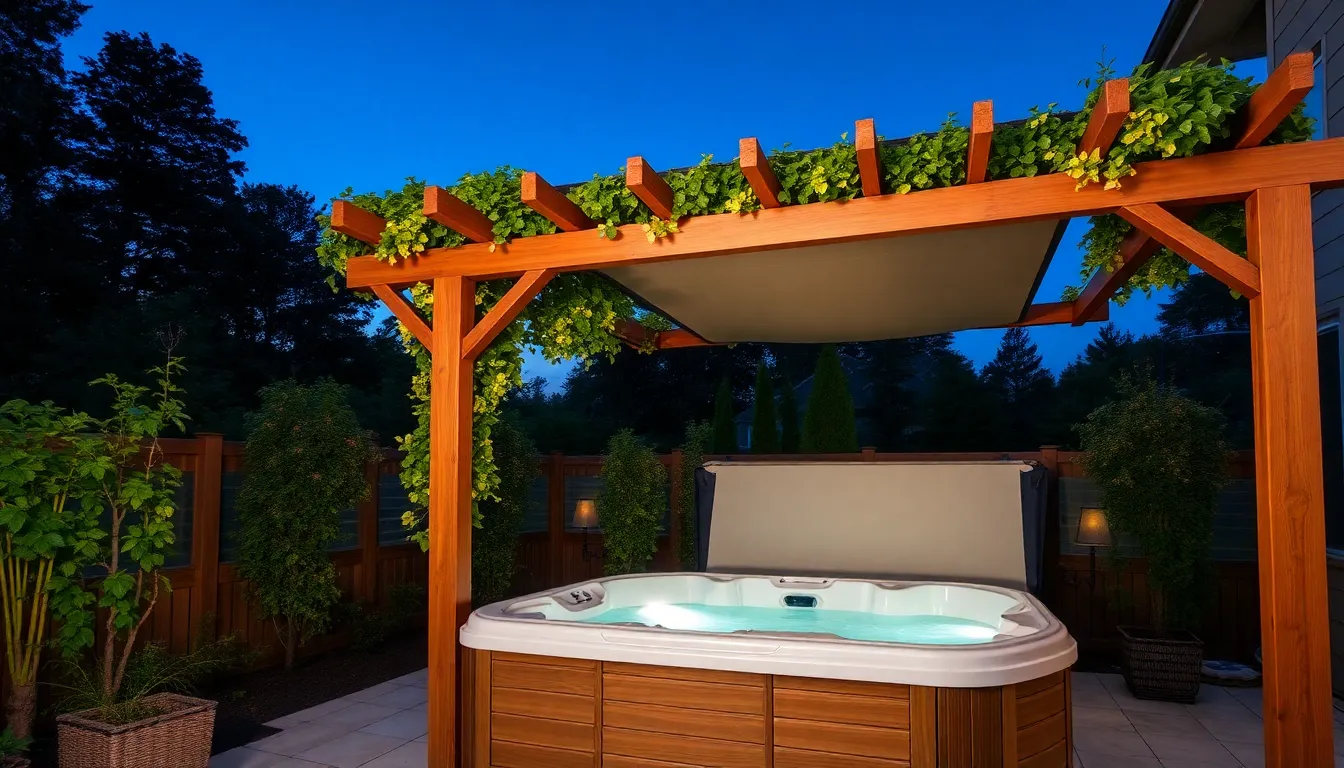
Combining gazebos and pergolas with your hot tub creates the perfect balance between shelter and open air relaxation. These structures transform your patio hot tub into a year-round outdoor sanctuary that provides protection from elements while maintaining an inviting atmosphere.
Wooden Pergola Structures
Wooden pergolas bring natural beauty to your hot tub area while providing the sturdy framework needed for a complete outdoor retreat. We recommend materials like western red cedar and redwood for their natural durability and resistance to moisture, which makes them ideal companions for steamy hot tub environments. These structures can be customized with rustic finishes for traditional patios or sleek modern stains for contemporary designs.
Building a wooden pergola around your hot tub creates multiple functional opportunities. The sturdy frame supports climbing plants like jasmine or grape vines, which naturally increase privacy and shade over time. You can also hang weather-resistant curtains or install screened panels between the posts for immediate privacy and wind protection.
Cost considerations for wooden pergolas vary significantly based on design complexity and material choices. DIY installations typically range from $1,500 to $4,000 for basic structures, while professional installations with custom features can reach $8,000 to $15,000. The investment pays dividends through increased home value and extended hot tub usability throughout different seasons.
Retractable Canopy Options
Retractable canopies add incredible flexibility to your hot tub pergola system by allowing you to adjust coverage based on weather conditions and personal preferences. Manual systems provide cost-effective answers that homeowners can operate with simple crank mechanisms, while motorized options offer push-button convenience for ultimate luxury.
These adjustable roof systems excel at temperature control around your hot tub area. During summer months, you can extend the canopy to keep the space cooler and reduce sun glare, while retracting it during cooler evenings allows stargazing and fresh air circulation. Winter protection becomes effortless when you can quickly cover the area during rain or snow.
StruXure leads the market in pergola and cabana products specifically designed for hot tub applications. Their systems integrate retractable roofs that protect from sun, rain, and snow while maintaining the open-air feel that makes hot tubbing so enjoyable. The versatility of these systems makes your outdoor investment usable in varied conditions throughout the year.
Integrated Lighting Systems
Lighting transforms your hot tub pergola into a stunning evening destination that extends usability well beyond daylight hours. LED strip lights installed along pergola beams create ambient illumination that highlights architectural features while providing safe navigation around water areas. These energy-efficient options consume minimal electricity while delivering maximum visual impact.
Smart lighting controls elevate your hot tub experience through customizable brightness and color options. Remote-controlled systems allow you to adjust lighting from the comfort of your hot tub, while smart home integration lets you program lighting schedules and create different moods for various occasions. Warm white lights promote relaxation, while colored options add festive atmosphere for entertaining.
Safety considerations make proper lighting essential around any hot tub installation. Spotlights strategically placed around steps and entry points prevent accidents during nighttime use, while hanging lanterns or pendant lights add decorative charm without creating harsh shadows. Waterproof fixtures rated for outdoor use ensure your lighting system withstands moisture and temperature fluctuations year-round.
Natural Stone Hot Tub Surrounds for Rustic Appeal
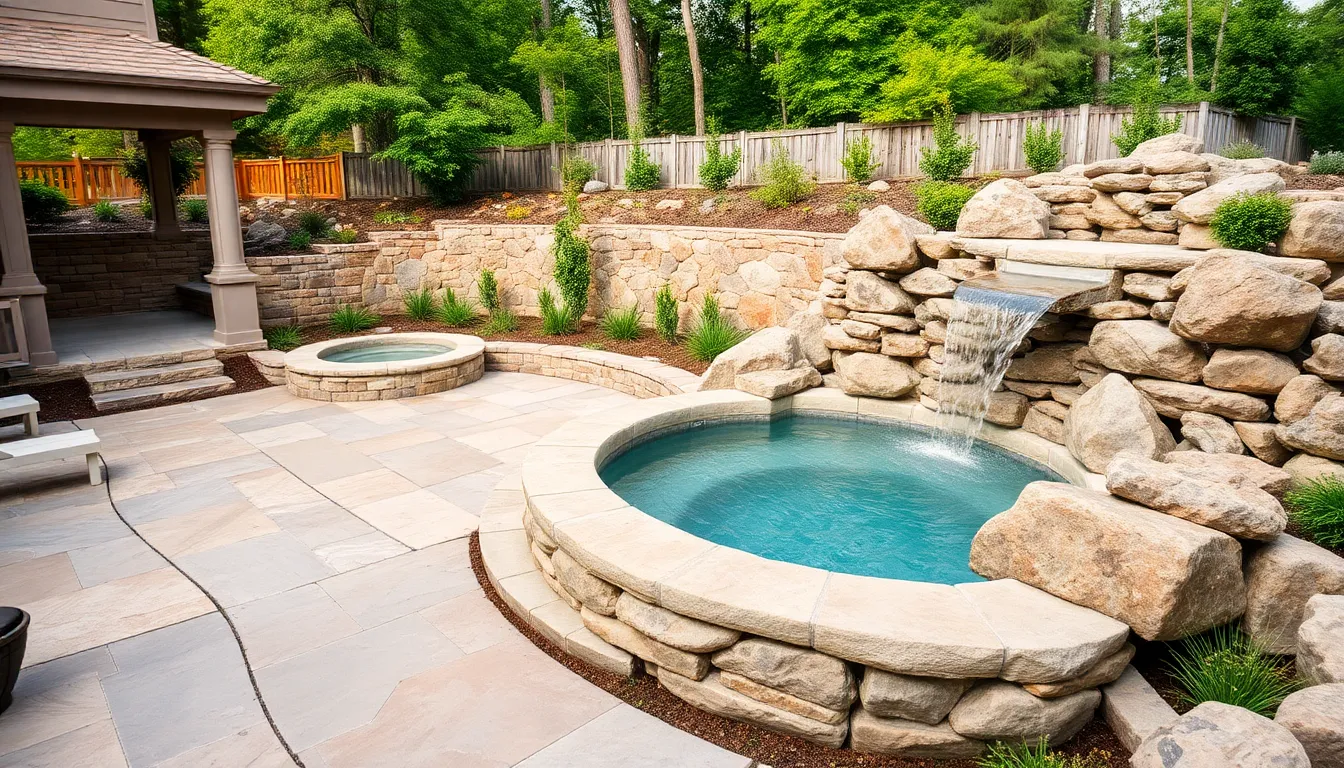
Natural stone transforms any hot tub installation into a sophisticated outdoor retreat that seamlessly blends with your industry design. Creating authentic rustic appeal means selecting stones that complement rather than compete with your existing patio elements.
Flagstone Installation Ideas
Flagstone provides the perfect foundation for hot tub patios due to its naturally flat surface and exceptional slip resistance. Installing flagstone as a complete patio creates a cohesive look that extends your hot tub area into the broader outdoor space. We recommend using thick slabs or multiple layers to accommodate varying ground levels while maintaining a level surface around your spa.
Stepping stone pathways offer an elegant alternative that guides guests to the hot tub while allowing ground cover plants to fill the gaps between stones. This approach creates visual interest and reduces the amount of hardscaping needed for your project. Capping flagstone edges with matching stone conceals structural elements and provides a polished finish that elevates the overall design.
Consider combining flagstone with gravel borders to enhance drainage and create natural transitions between different areas of your patio. The texture contrast between smooth flagstone and rough gravel adds depth to your design while serving practical purposes.
River Rock Accents
River rocks introduce soft, rounded forms that balance the angular lines of flagstone and other hardscaping materials. These smooth stones work exceptionally well as borders around planting areas or as decorative ground cover beneath trees and shrubs. We’ve found that strategically placing river rock alongside existing plants creates a naturalistic industry that promotes relaxation.
Drainage benefits make river rock particularly valuable around hot tub installations where water overflow and splash occur regularly. The porous nature of river rock installations prevents standing water while reducing soil erosion around your spa area. Using different sizes of river rock creates visual texture and allows you to customize the look based on your exact design preferences.
Maintenance requirements for river rock accents remain minimal compared to traditional mulch or other organic ground covers. The stones maintain their appearance year round and won’t require seasonal replacement or refreshing like organic materials.
Waterfall Feature Integration
Waterfall features elevate your hot tub experience by adding soothing water sounds and visual movement to your outdoor space. Building these features using stacked natural stones or boulders creates a focal point that appears naturally formed rather than artificially constructed. We recommend positioning waterfalls to flow either directly into the hot tub or into a nearby basin that complements your stone surround design.
Natural flow patterns should guide your waterfall placement to maintain harmony with existing stones and landscaping elements. Stones that transform visually when wet add ever-changing appeal to your spa area, creating different looks throughout the day as water flows over their surfaces. This visual transformation keeps your outdoor space interesting and captivating for regular users.
Pump systems for waterfall features can be integrated discretely within your stone surround, maintaining the natural aesthetic while providing reliable water circulation. The combination of flowing water and natural stone creates a serene environment that enhances the therapeutic benefits of your hot tub sessions.
Modern Hot Tub Designs with Clean Lines
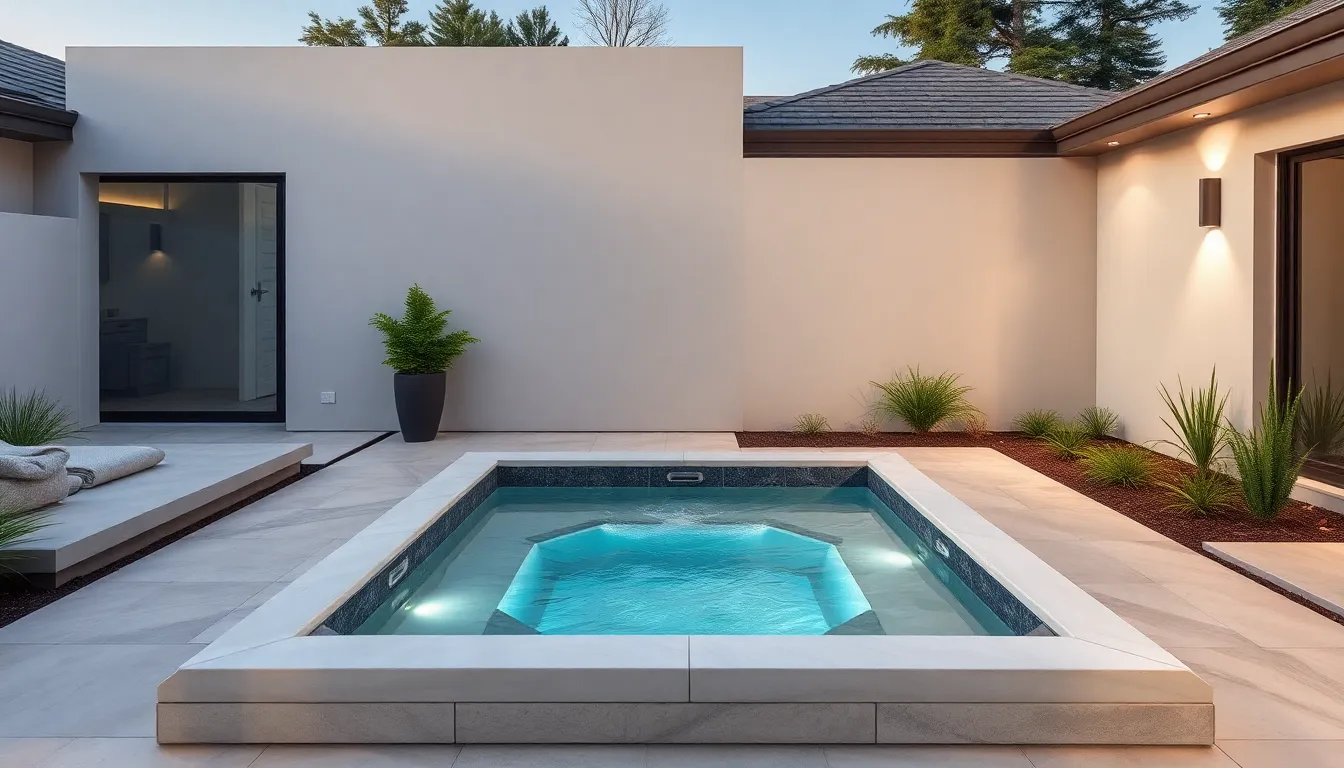
Modern hot tub installations transform patios into sophisticated retreats through sleek, simple forms and smooth edges. These contemporary designs integrate seamlessly with minimalist landscaping while creating striking focal points for outdoor entertainment.
Minimalist Concrete Surrounds
Concrete surrounds deliver the ultimate in modern sophistication while providing exceptional durability for heavy use. Stamped concrete offers textured surfaces that prevent slipping while maintaining clean aesthetic lines around your hot tub perimeter. Polished concrete creates mirror-like finishes that reflect surrounding industry elements and enhance the water’s natural fluidity.
Extending your patio flooring up the hot tub sides creates visual unity that eliminates jarring height transitions. This technique blurs boundaries between different outdoor zones while establishing a cohesive design theme throughout your backyard space. We recommend using matching concrete tones to connect your hot tub surround with existing walkways and seating areas.
Geometric Shape Options
Square hot tubs emphasize architectural precision while fitting perfectly into contemporary patio layouts with defined boundaries. Rectangular models create dramatic linear statements that complement modern homes with similar geometric features. These structured shapes move beyond traditional circular designs to establish order and sophistication in your outdoor space.
Sunken geometric installations add architectural drama while providing practical maintenance access beneath the structure. Stone or concrete perimeters around sunken tubs create distinctive “moat” effects that serve both functional and aesthetic purposes. Built-out borders offer comfortable seating ledges while maintaining the clean lines essential to modern design principles.
Contemporary Material Choices
Natural stone elements provide timeless appeal while offering exceptional weather resistance for year-round outdoor use. Composite panels deliver sleek surfaces that require minimal maintenance while maintaining their appearance through extreme temperature changes. These materials ensure your hot tub investment remains beautiful and functional for decades of enjoyment.
Stone installations around sunken hot tubs create sophisticated perimeter treatments that tie into other patio hardscaping elements. Concrete options blend seamlessly with modern architectural styles while providing customizable color and texture combinations. Quality materials connect your hot tub visually to surrounding decks, pergolas, and outdoor furniture for a unified entertaining environment.
Hot Tub Privacy Solutions for Backyard Patios

Creating a private oasis around your hot tub transforms your backyard patio into a secluded retreat where you can relax without worrying about prying eyes. We’ll explore various privacy answers that blend seamlessly with your industry while improving both comfort and aesthetic appeal.
Landscaping Screen Ideas
Climbing vines and hedges create the most natural privacy barriers around your hot tub area. Tall shrubs like arborvitae or privet hedges provide year-round coverage while maintaining an organic feel. Grasses such as bamboo or fountain grass add movement and texture to your privacy screen. Living walls and vertical gardens maximize your space while delivering lush, green partitions that serve as both functional barriers and decorative elements.
Bamboo screens and decorative partitions offer flexible installation options that you can reposition as your needs change. Tall planters filled with ornamental grasses or flowering shrubs create moveable privacy walls. Decorative metal or wooden partitions add visual interest while blocking sightlines from neighboring properties. These answers work particularly well when you need temporary privacy or want to experiment with different layouts before committing to permanent installations.
Fence Design Options
Slatted and wooden fences deliver instant privacy with customizable height, color, and style options to match your patio décor. Solid wood fences block sightlines completely while reducing noise levels and preventing unauthorized access to your hot tub area. Cedar and redwood fences provide natural weather resistance and attractive grain patterns. Horizontal slat designs create a modern aesthetic while vertical boards offer traditional appeal.
Railing safety screens work perfectly for hot tubs installed on decks or elevated platforms. Panels with decorative infills can be transparent or opaque depending on your desired privacy level. Glass panels maintain views while creating wind barriers. Metal railings with privacy inserts combine safety requirements with seclusion needs. These screens integrate seamlessly with existing deck railings for a cohesive appearance.
Strategic Placement Tips
Positioning against the house instantly creates privacy on multiple sides of your hot tub installation. This placement takes advantage of your home’s existing structure while reducing the need for additional screening. You can add portable screens or plants to cover the remaining exposed sides. Corner locations between house walls and existing fences maximize natural privacy barriers.
Elevated placement helps break sightlines from neighboring yards without requiring tall privacy walls. Raised decks or platforms naturally increase privacy while creating dramatic visual impact. Multi level designs separate your hot tub area from ground level activities. These installations work especially well when combined with strategic landscaping at ground level.
Gazebos, canopies, and pergolas provide comprehensive privacy answers that protect from both prying eyes and weather elements. Gazebos with enclosed sides create complete seclusion while pergolas allow for climbing plants and retractable curtains. Canopies with side panels offer adjustable privacy levels throughout different seasons. These structures can be customized with lighting and heating elements for year round enjoyment.
Lighting Ideas to Enhance Hot Tub Ambiance
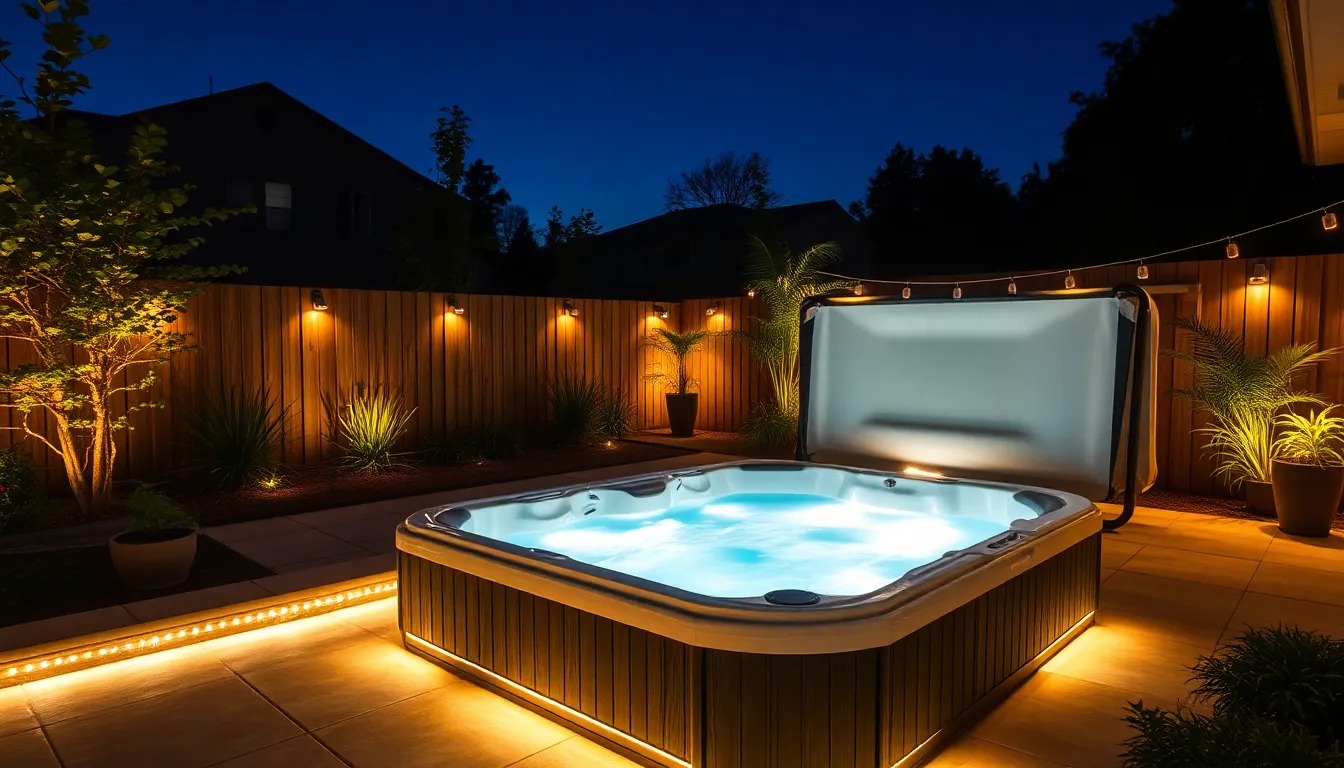
Well-designed lighting transforms your hot tub area from a simple backyard feature into a stunning evening retreat. Strategic illumination enhances both safety and ambiance while creating the perfect atmosphere for relaxation after dark.
LED Strip Installation
LED strips provide the most versatile and energy-efficient solution for outlining your hot tub area. These waterproof lights contour perfectly around hot tub edges and decking, creating an ambient glow that defines the space beautifully. Installing LED rope lights along pathways and steps enhances safety by illuminating potential hazards while maintaining aesthetic appeal.
Customization options with LED strips include multiple colors and brightness levels to match any desired mood. Energy efficiency reduces electricity consumption significantly compared to traditional lighting options. Flexible installation allows you to follow curved edges and unique architectural features seamlessly.
Solar-Powered Options
Solar lights offer an eco-friendly approach that charges during daylight hours and provides soft illumination throughout the evening. Cost savings become substantial over time since these lights eliminate ongoing electricity expenses. Pathway lighting using solar fixtures guides guests safely to and from the hot tub area.
Landscaping enhancement occurs naturally as solar lights highlight surrounding plants and decorative elements without running electrical lines. Weather resistance in quality solar fixtures ensures reliable performance across seasons. Low maintenance requirements make solar options particularly attractive for busy homeowners.
Underwater Lighting Effects
Underwater LED lights create the most dramatic visual impact by producing a captivating glow beneath the water’s surface. Color-changing capabilities allow you to customize the mood from relaxing blues to energizing reds instantly. Pre-equipped hot tubs often include these lighting systems with remote controls for easy operation.
Safety improvements result from better visibility within the hot tub during nighttime use. Therapeutic benefits increase as the soothing light effects enhance the overall relaxation experience. Professional installation ensures proper waterproofing and electrical safety for long-term enjoyment.
Combining multiple lighting types creates layered illumination that balances functionality with visual appeal, transforming your backyard patio into a radiant hot tub sanctuary.
Hot Tub Landscaping Ideas for Natural Beauty
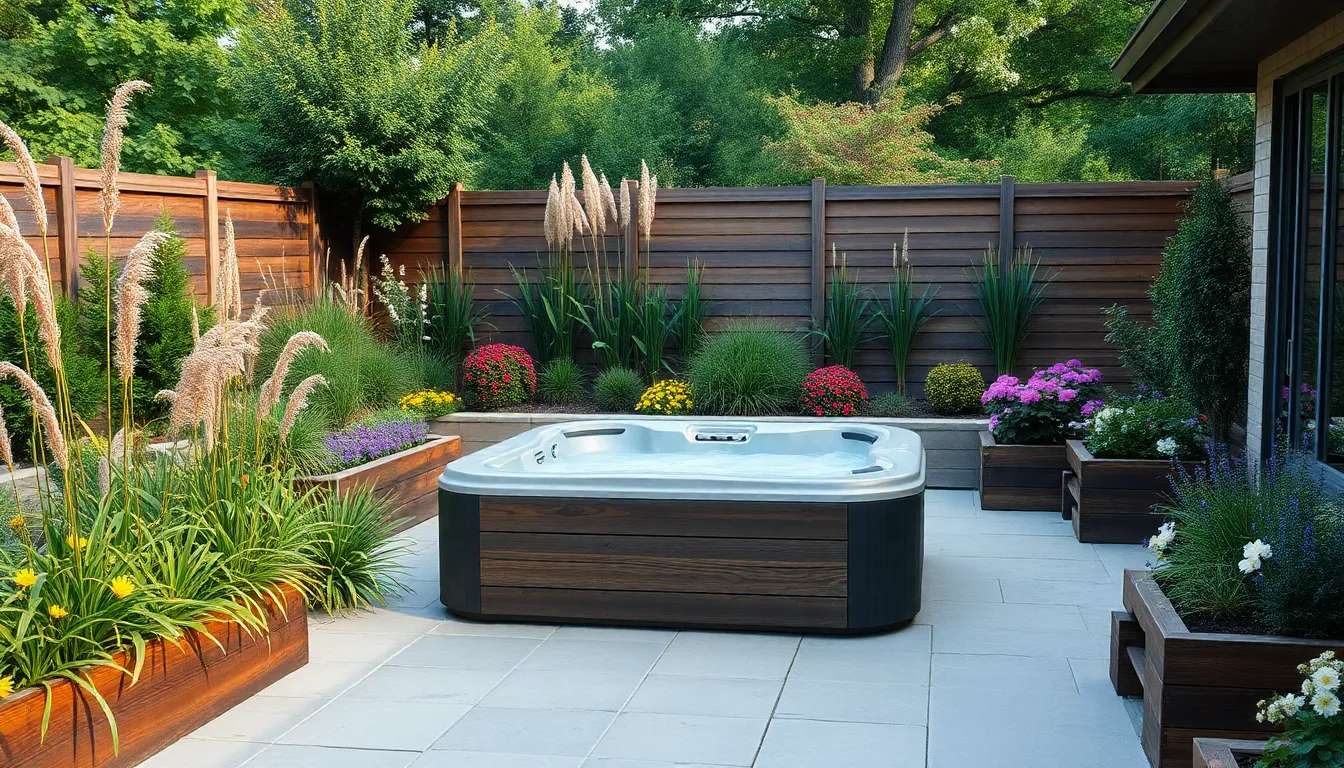
Thoughtful landscaping transforms our hot tub area from a simple addition into a serene natural retreat. We’ll explore how strategic plant choices and design elements create a cohesive outdoor sanctuary.
Plant Selection Guidelines
Soft textured plants blur harsh edges around our hot tub installation. Ornamental grasses like Mexican feathergrass and festuca glauca nestle beautifully around concrete hardscaping to create a relaxed ambiance. We recommend choosing hardy, low maintenance varieties that thrive in moisture and heat from the tub’s environment.
Evergreen selections provide year round greenery while seasonal plants add bursts of color. Mix these plant types to maintain visual interest throughout changing seasons. Consider fragrant options like lavender or jasmine for added sensory appeal during our evening soaks.
Climate appropriate species ensure our landscaping investment thrives long term. Select plants that tolerate both the hot tub’s humid microclimate and our local weather conditions. This approach reduces maintenance while keeping our spa area beautiful throughout the year.
Garden Border Designs
Raised beds shaped to complement our hot tub’s geometry create visual harmony. Use chunky timber sleepers or cube shaped planters that mimic the spa’s form for a cohesive minimalist aesthetic. These borders emphasize the connection between hardscaping and natural elements.
Contrasting materials make garden borders pop with visual interest. Combine natural stone edging with standout plantings to define spaces clearly. Choose durable materials like pavers or decorative stones that harmonize with existing patio elements.
Multi level border designs add depth and dimension around our hot tub. Create stepped planting areas using different heights and textures to guide the eye naturally. This layered approach softens the transition between our spa and surrounding industry.
Seasonal Decoration Tips
Colorful seasonal planters refresh our hot tub area throughout the year. Swap out flowers and foliage to match each season’s palette. Spring bulbs, summer annuals, autumn mums, and winter evergreens keep the space vibrant and inviting.
Weather resistant lighting creates ambiance during cooler months and evening sessions. String lights, lanterns, and pathway illumination extend our enjoyment beyond daylight hours. Choose outdoor rated fixtures that withstand moisture and temperature changes.
Comfort accessories adapt our spa area for seasonal use. Add weather resistant cushions and throws that provide warmth and color variety. Incorporate seasonal accents like pumpkins in fall or evergreen boughs in winter to maintain visual appeal year round.
Budget-Friendly Hot Tub Patio Transformations
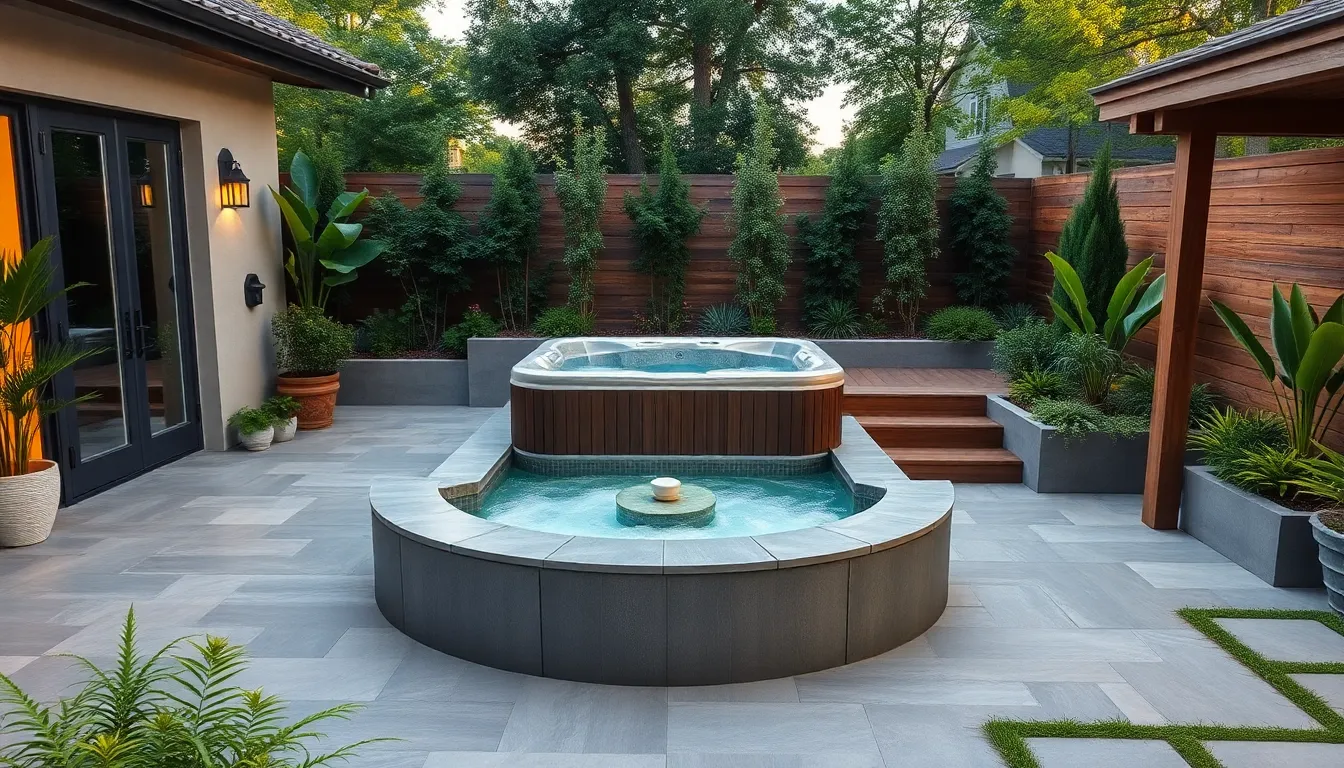
Creating a cohesive patio design doesn’t require very costly. Smart planning and strategic material choices can transform your backyard into a luxurious retreat without the premium price tag.
DIY Installation Options
Above-ground installations offer the most accessible entry point for budget-conscious homeowners. We can position these hot tubs directly on existing decks or patios, eliminating costly excavation and groundwork. This approach reduces installation complexity while maintaining professional aesthetics.
Square and geometric layouts using paving stones or timber sleepers create visually appealing designs that appear professionally installed. These shapes naturally complement most hot tub forms and provide excellent structural support. Careful planning with these materials ensures the finished project rivals expensive contractor installations.
Electrical and plumbing considerations become more manageable with strategic placement decisions. Positioning the hot tub near existing electrical sources reduces wiring costs significantly. Similarly, keeping plumbing runs short and accessible prevents expensive trenching and complex routing challenges.
Cost-Effective Material Choices
Stamped concrete surfaces deliver upscale aesthetics at fraction of natural stone costs. This versatile material mimics expensive textures while providing excellent durability and slip resistance. We can customize patterns and colors to match existing patio elements seamlessly.
Porcelain tiles and cube-shaped pavers create sophisticated looks without premium pricing. These materials offer consistent sizing and easy installation for DIY projects. Their weather resistance ensures long-term performance in hot tub environments with minimal replacement needs.
Wood sleepers for decking and steps provide natural warmth at affordable prices. These materials blend beautifully with landscaping elements and hot tub designs. Proper sealing and maintenance extend their lifespan considerably, making them excellent value investments.
| Material Type | Average Cost per Sq Ft | Durability Rating | DIY Difficulty |
|---|---|---|---|
| Stamped Concrete | $8-12 | High | Moderate |
| Porcelain Tiles | $5-10 | Very High | Easy |
| Wood Sleepers | $3-7 | Moderate | Easy |
| Cube Pavers | $6-9 | High | Easy |
Maintenance Saving Tips
Built-out stone areas around hot tubs help easy electrical and structural maintenance access. This design prevents costly tub removal for future repairs or upgrades. Strategic placement of access panels during initial construction saves thousands in potential maintenance costs.
Regular cleaning routines and proper cover usage significantly reduce debris accumulation and chemical requirements. These simple practices lower ongoing operational expenses while extending equipment lifespan. Consistent maintenance schedules prevent major repair bills from developing over time.
Accessibility design features ensure all mechanical components remain reachable without structural modifications. Planning maintenance pathways during installation eliminates future access challenges. These considerations protect your investment while minimizing long-term service expenses.
Conclusion
We’ve explored countless ways to transform your backyard patio into a luxurious hot tub retreat that perfectly matches your lifestyle and budget. From sleek modern designs to rustic stone surrounds each approach offers unique benefits that’ll enhance your outdoor living experience.
The key to success lies in thoughtful planning that considers your space limitations privacy needs and long-term maintenance requirements. Whether you’re drawn to elevated deck installations corner placements or ground-level designs the right choice depends on your exact patio layout and personal preferences.
Remember that creating your dream hot tub area doesn’t have to expensive. With smart material choices DIY-friendly options and strategic design decisions you can achieve that resort-like atmosphere right in your own backyard. Your new hot tub sanctuary will become the centerpiece of countless memorable evenings with family and friends.
Frequently Asked Questions
How much does it cost to add a hot tub to my patio?
Hot tub patio transformations can be budget-friendly with smart planning. DIY above-ground installations are the most affordable option, allowing direct placement on existing decks or patios. Cost-effective materials like stamped concrete, porcelain tiles, or wood sleepers can create an attractive surround without premium pricing. Professional installations with built-in features will cost more but add significant home value.
What are the best materials for hot tub surrounds?
Popular materials include natural stone (flagstone, river rock), composite materials, and concrete. Flagstone offers slip resistance and aesthetic appeal, while composite materials provide superior durability and eco-friendly properties. Concrete surrounds, especially stamped or polished varieties, offer modern appeal and longevity. Choose materials that complement your existing patio and provide safe, non-slip surfaces.
Do I need professional installation for a hot tub patio?
While professional installation ensures proper electrical and plumbing connections, many hot tub patio projects can be DIY-friendly. Above-ground installations on existing surfaces are most accessible for homeowners. However, sunken installations, deck-level designs, and complex electrical work require professional expertise for safety and building code compliance.
How can I create privacy around my hot tub?
Privacy solutions include landscaping screens with climbing vines or tall shrubs, bamboo screens, decorative partitions, and fence designs. Gazebos, pergolas, and canopies provide comprehensive privacy while offering weather protection. Strategic placement against the house or in elevated locations naturally enhances seclusion. Combine multiple approaches for optimal privacy.
What lighting options work best for hot tub areas?
Effective hot tub lighting includes LED strips for outlining, solar-powered lights for eco-friendly illumination, and underwater LED lights for dramatic effects. Layer different lighting types to balance functionality with ambiance. Smart lighting controls allow customizable experiences for different moods. Always prioritize safety with proper electrical installation and waterproof fixtures.
How do I maintain my hot tub patio area?
Regular maintenance includes cleaning surrounding surfaces, checking accessibility to mechanical components, and seasonal upkeep. Design built-out stone areas for easy access to electrical and structural elements. Choose low-maintenance plants that thrive in humid environments. Establish regular cleaning routines and ensure all service areas remain reachable to minimize long-term expenses.
What plants work best around hot tubs?
Select soft-textured, low-maintenance plants that thrive in humid conditions. Evergreen plants provide year-round visual interest, while seasonal plants add variety. Avoid plants with thorns or excessive debris that could affect water quality. Consider raised beds with proper drainage and choose species that complement your overall landscape design while requiring minimal upkeep.
Can I install a hot tub in a small patio space?
Yes, compact hot tub designs maximize therapeutic benefits while occupying minimal space. Corner installations optimize unused areas and maintain patio layout flow. Models like the Master Spas TS 240 demonstrate how powerful jets and lounge areas fit into smaller footprints. L-shaped patio designs can accommodate hot tubs at corner junctions effectively.

